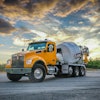High-performance Tercem 3000 blended cement supplied by Lafarge is playing a key role in the $226 million renovation and expansion of Michigan Stadium in Ann Arbor. The three-year construction project, which began after the last home game in 2007, includes preservation of the existing historic structure as well as stadium enhancements that will improve the game-day experience for University of Michigan Wolverines fans.
Known as the "Big House", the University of Michigan football stadium is the fourth largest stadium in the world. The current renovation and expansion project, which has been phased so that home games and commencement ceremonies can continue as planned, involves replacement of bleachers, widening of seats and aisles, the addition of a 83 luxury boxes and 3,200 club seats, and the construction of a new press box, restrooms, concession areas, and concourses. Seating capacity will top 108,000 when the newly renovated stadium is complete.
Although work on the project will continue until the beginning of the 2010 football season, some major construction milestones already have been reached-including the removal of the existing bowl floor and replacing it with concrete containing Tercem 3000 blended cement from Lafarge's state-of-the-art terminal in Detroit. This highly automated cement terminal contains an on-demand blender capable of producing precisely proportioned custom blends of cementitious products quickly, efficiently, and with great accuracy. Clawson & Killins Concrete Companies and Walker Parking Consultants agreed that allowing Lafarge to custom blend Tercem 3000 would enable them to produce a concrete containing excellent uniformity, finishability, and superior hardened properties.
Tercem 3000 is a high-performance blend of slag cement, silica fume, and Portland cement. It is precisely formulated for high strength, improved durability, and superior placing and finishing qualities. It provides significant performance benefits, including improved 28-day strengths, reduced permeability, improved rheology and pumpability of concrete (especially in hot weather), reduced concrete bleeding, as well as improved resistance to alkali-silica reaction. "Using Tercem 3000 optimized batching, mixing, placing, and finishing characteristics, ultimately delivering an exceptionally sound concrete that will certainly stand the test of time at the Big House," said Claude Bergeron, the project's technical services engineer for Lafarge.
Tercem 3000 delivers environmental benefits as well. Production of Tercem 3000 uses less energy and reduces carbon dioxide emissions compared to conventional cement manufacturing. Using materials reclaimed from steel-making and silicon metals operations, it is recognized as a "recovered" product by the U.S. Environmental Protection Agency and can help projects earn points toward certification under the LEED Green Building Rating System of the U.S. Green Building Council (USGBC).

















